stop start Alfa Romeo 147 2006 Owner handbook (in English)
[x] Cancel search | Manufacturer: ALFA ROMEO, Model Year: 2006, Model line: 147, Model: Alfa Romeo 147 2006Pages: 291, PDF Size: 5.52 MB
Page 137 of 291
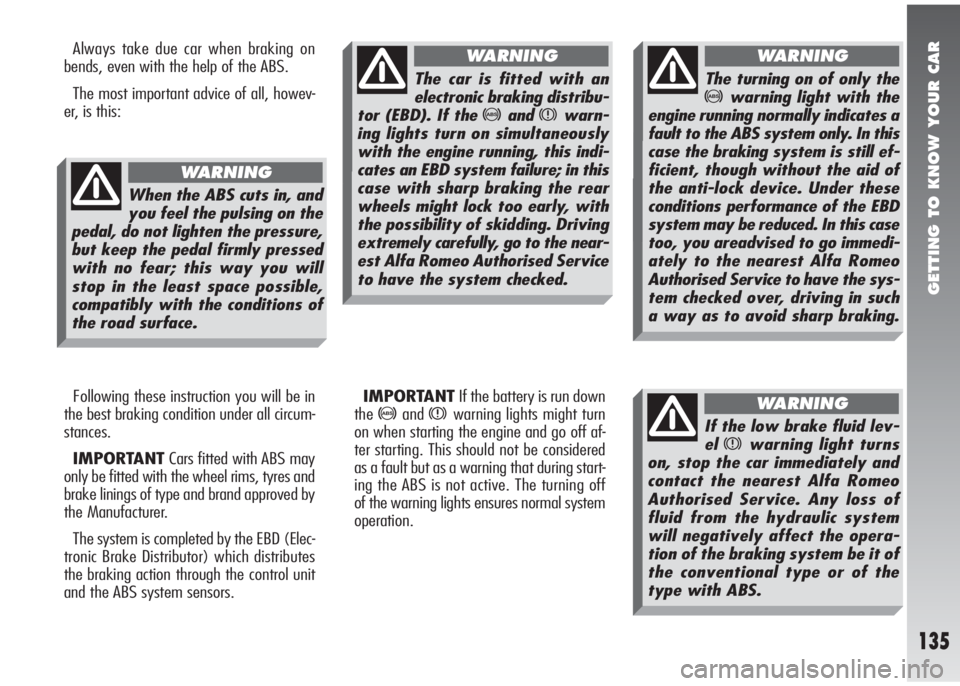
GETTING TO KNOW YOUR CAR
135
Always take due car when braking on
bends, even with the help of the ABS.
The most important advice of all, howev-
er, is this:
Following these instruction you will be in
the best braking condition under all circum-
stances.
IMPORTANTCars fitted with ABS may
only be fitted with the wheel rims, tyres and
brake linings of type and brand approved by
the Manufacturer.
The system is completed by the EBD (Elec-
tronic Brake Distributor) which distributes
the braking action through the control unit
and the ABS system sensors.IMPORTANTIf the battery is run down
the
>andxwarning lights might turn
on when starting the engine and go off af-
ter starting. This should not be considered
as a fault but as a warning that during start-
ing the ABS is not active. The turning off
of the warning lights ensures normal system
operation.
When the ABS cuts in, and
you feel the pulsing on the
pedal, do not lighten the pressure,
but keep the pedal firmly pressed
with no fear; this way you will
stop in the least space possible,
compatibly with the conditions of
the road surface.
WARNING
The car is fitted with an
electronic braking distribu-
tor (EBD). If the
>andxwarn-
ing lights turn on simultaneously
with the engine running, this indi-
cates an EBD system failure; in this
case with sharp braking the rear
wheels might lock too early, with
the possibility of skidding. Driving
extremely carefully, go to the near-
est Alfa Romeo Authorised Service
to have the system checked.
WARNING
The turning on of only the
>warning light with the
engine running normally indicates a
fault to the ABS system only. In this
case the braking system is still ef-
ficient, though without the aid of
the anti-lock device. Under these
conditions performance of the EBD
system may be reduced. In this case
too, you areadvised to go immedi-
ately to the nearest Alfa Romeo
Authorised Service to have the sys-
tem checked over, driving in such
a way as to avoid sharp braking.
WARNING
If the low brake fluid lev-
el
xwarning light turns
on, stop the car immediately and
contact the nearest Alfa Romeo
Authorised Service. Any loss of
fluid from the hydraulic system
will negatively affect the opera-
tion of the braking system be it of
the conventional type or of the
type with ABS.
WARNING
Page 152 of 291
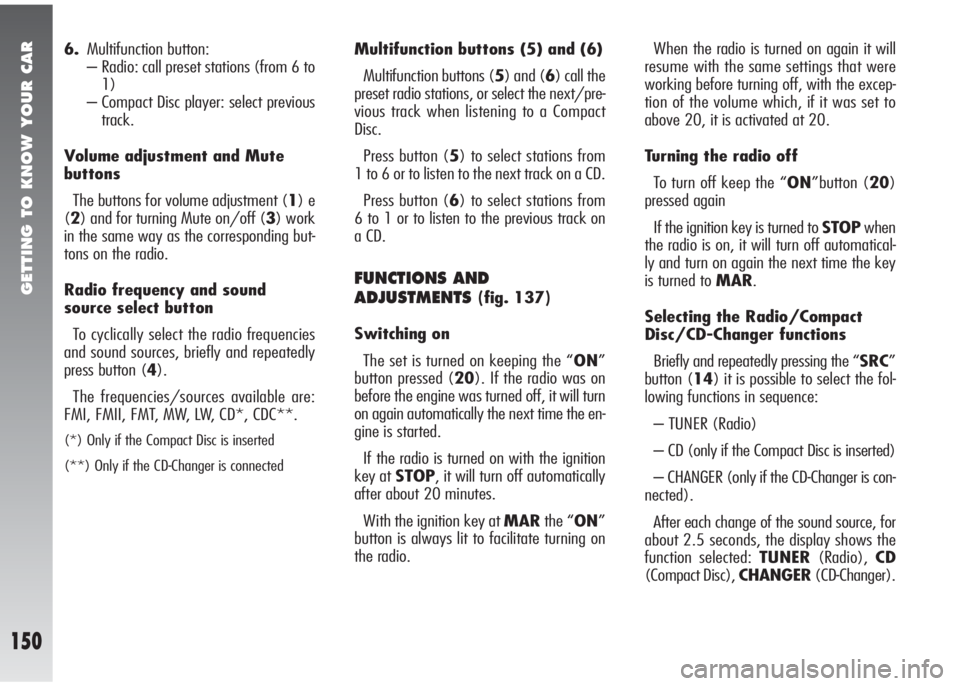
GETTING TO KNOW YOUR CAR
150
6.Multifunction button:
– Radio: call preset stations (from 6 to
1)
– Compact Disc player: select previous
track.
Volume adjustment and Mute
buttons
The buttons for volume adjustment (1) e
(2) and for turning Mute on/off (3) work
in the same way as the corresponding but-
tons on the radio.
Radio frequency and sound
source select button
To cyclically select the radio frequencies
and sound sources, briefly and repeatedly
press button (4).
The frequencies/sources available are:
FMI, FMII, FMT, MW, LW, CD*, CDC**.
(*) Only if the Compact Disc is inserted
(**) Only if the CD-Changer is connected
Multifunction buttons (5) and (6)
Multifunction buttons (5) and (6) call the
preset radio stations, or select the next/pre-
vious track when listening to a Compact
Disc.
Press button (5) to select stations from
1 to 6 or to listen to the next track on a CD.
Press button (6) to select stations from
6 to 1 or to listen to the previous track on
a CD.
FUNCTIONS AND
ADJUSTMENTS
(fig. 137)
Switching on
The set is turned on keeping the “ON”
button pressed (20). If the radio was on
before the engine was turned off, it will turn
on again automatically the next time the en-
gine is started.
If the radio is turned on with the ignition
key at STOP, it will turn off automatically
after about 20 minutes.
With the ignition key at MARthe “ON”
button is always lit to facilitate turning on
the radio.When the radio is turned on again it will
resume with the same settings that were
working before turning off, with the excep-
tion of the volume which, if it was set to
above 20, it is activated at 20.
Turning the radio off
To turn off keep the “ON”button (20)
pressed again
If the ignition key is turned to STOPwhen
the radio is on, it will turn off automatical-
ly and turn on again the next time the key
is turned to MAR.
Selecting the Radio/Compact
Disc/CD-Changer functions
Briefly and repeatedly pressing the “SRC”
button (14) it is possible to select the fol-
lowing functions in sequence:
– TUNER (Radio)
– CD (only if the Compact Disc is inserted)
– CHANGER (only if the CD-Changer is con-
nected).
After each change of the sound source, for
about 2.5 seconds, the display shows the
function selected: TUNER(Radio),CD
(Compact Disc), CHANGER(CD-Changer).
Page 153 of 291
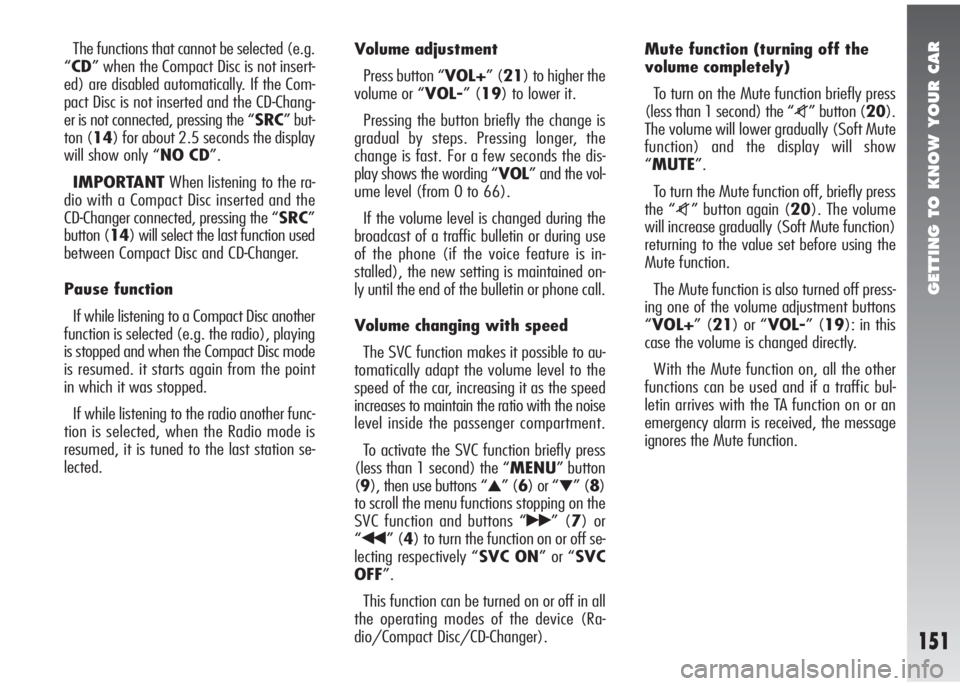
GETTING TO KNOW YOUR CAR
151
The functions that cannot be selected (e.g.
“CD” when the Compact Disc is not insert-
ed) are disabled automatically. If the Com-
pact Disc is not inserted and the CD-Chang-
er is not connected, pressing the “SRC” but-
ton (14) for about 2.5 seconds the display
will show only “NO CD”.
IMPORTANTWhen listening to the ra-
dio with a Compact Disc inserted and the
CD-Changer connected, pressing the “SRC”
button (14) will select the last function used
between Compact Disc and CD-Changer.
Pause function
If while listening to a Compact Disc another
function is selected (e.g. the radio), playing
is stopped and when the Compact Disc mode
is resumed. it starts again from the point
in which it was stopped.
If while listening to the radio another func-
tion is selected, when the Radio mode is
resumed, it is tuned to the last station se-
lected.Volume adjustment
Press button “VOL+” (21) to higher the
volume or “VOL-” (19) to lower it.
Pressing the button briefly the change is
gradual by steps. Pressing longer, the
change is fast. For a few seconds the dis-
play shows the wording “VOL” and the vol-
ume level (from 0 to 66).
If the volume level is changed during the
broadcast of a traffic bulletin or during use
of the phone (if the voice feature is in-
stalled), the new setting is maintained on-
ly until the end of the bulletin or phone call.
Volume changing with speed
The SVC function makes it possible to au-
tomatically adapt the volume level to the
speed of the car, increasing it as the speed
increases to maintain the ratio with the noise
level inside the passenger compartment.
To activate the SVC function briefly press
(less than 1 second) the “MENU” button
(9), then use buttons “
▲” (6) or “▼” (8)
to scroll the menu functions stopping on the
SVC function and buttons “
˙˙” (7) or
“
¯¯” (4) to turn the function on or off se-
lecting respectively “SVC ON” or “SVC
OFF”.
This function can be turned on or off in all
the operating modes of the device (Ra-
dio/Compact Disc/CD-Changer).Mute function (turning off the
volume completely)
To turn on the Mute function briefly press
(less than 1 second) the “
z” button (20).
The volume will lower gradually (Soft Mute
function) and the display will show
“MUTE”.
To turn the Mute function off, briefly press
the “
z” button again (20). The volume
will increase gradually (Soft Mute function)
returning to the value set before using the
Mute function.
The Mute function is also turned off press-
ing one of the volume adjustment buttons
“VOL+” (21) or “VOL-” (19): in this
case the volume is changed directly.
With the Mute function on, all the other
functions can be used and if a traffic bul-
letin arrives with the TA function on or an
emergency alarm is received, the message
ignores the Mute function.
Page 156 of 291
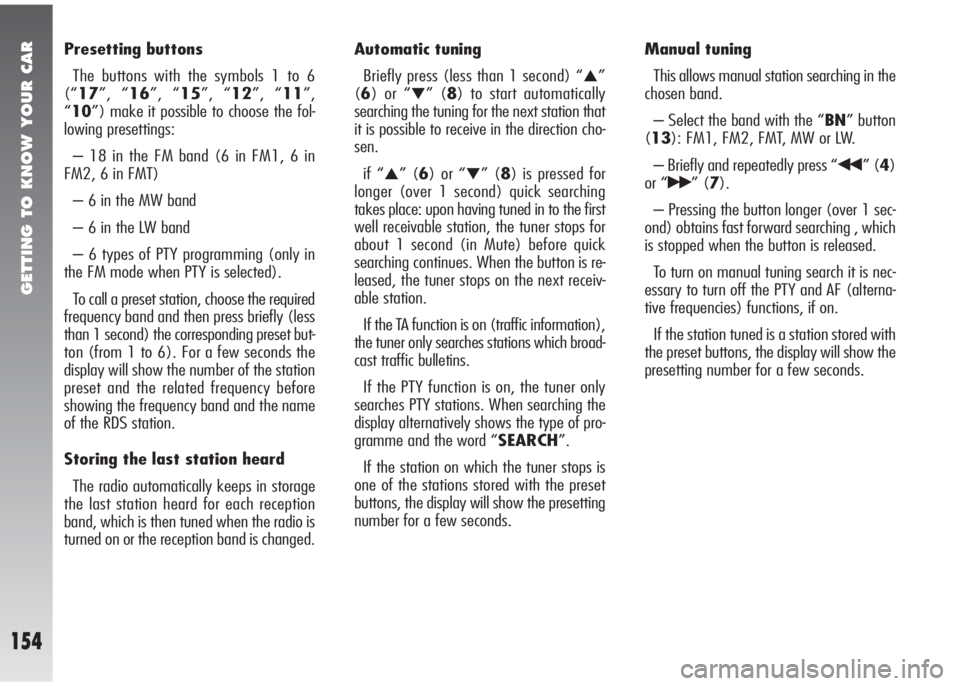
GETTING TO KNOW YOUR CAR
154
Presetting buttons
The buttons with the symbols 1 to 6
(“17”, “16”, “15”, “12”, “11”,
“10”) make it possible to choose the fol-
lowing presettings:
– 18 in the FM band (6 in FM1, 6 in
FM2, 6 in FMT)
– 6 in the MW band
– 6 in the LW band
– 6 types of PTY programming (only in
the FM mode when PTY is selected).
To call a preset station, choose the required
frequency band and then press briefly (less
than 1 second) the corresponding preset but-
ton (from 1 to 6). For a few seconds the
display will show the number of the station
preset and the related frequency before
showing the frequency band and the name
of the RDS station.
Storing the last station heard
The radio automatically keeps in storage
the last station heard for each reception
band, which is then tuned when the radio is
turned on or the reception band is changed.Automatic tuning
Briefly press (less than 1 second) “
▲”
(6) or “
▼” (8) to start automatically
searching the tuning for the next station that
it is possible to receive in the direction cho-
sen.
if “
▲” (6) or “▼” (8) is pressed for
longer (over 1 second) quick searching
takes place: upon having tuned in to the first
well receivable station, the tuner stops for
about 1 second (in Mute) before quick
searching continues. When the button is re-
leased, the tuner stops on the next receiv-
able station.
If the TA function is on (traffic information),
the tuner only searches stations which broad-
cast traffic bulletins.
If the PTY function is on, the tuner only
searches PTY stations. When searching the
display alternatively shows the type of pro-
gramme and the word “SEARCH”.
If the station on which the tuner stops is
one of the stations stored with the preset
buttons, the display will show the presetting
number for a few seconds.Manual tuning
This allows manual station searching in the
chosen band.
– Select the band with the “BN” button
(13): FM1, FM2, FMT, MW or LW.
– Briefly and repeatedly press “¯¯” (4)
or “
˙˙” (7).
– Pressing the button longer (over 1 sec-
ond) obtains fast forward searching , which
is stopped when the button is released.
To turn on manual tuning search it is nec-
essary to turn off the PTY and AF (alterna-
tive frequencies) functions, if on.
If the station tuned is a station stored with
the preset buttons, the display will show the
presetting number for a few seconds.
Page 177 of 291
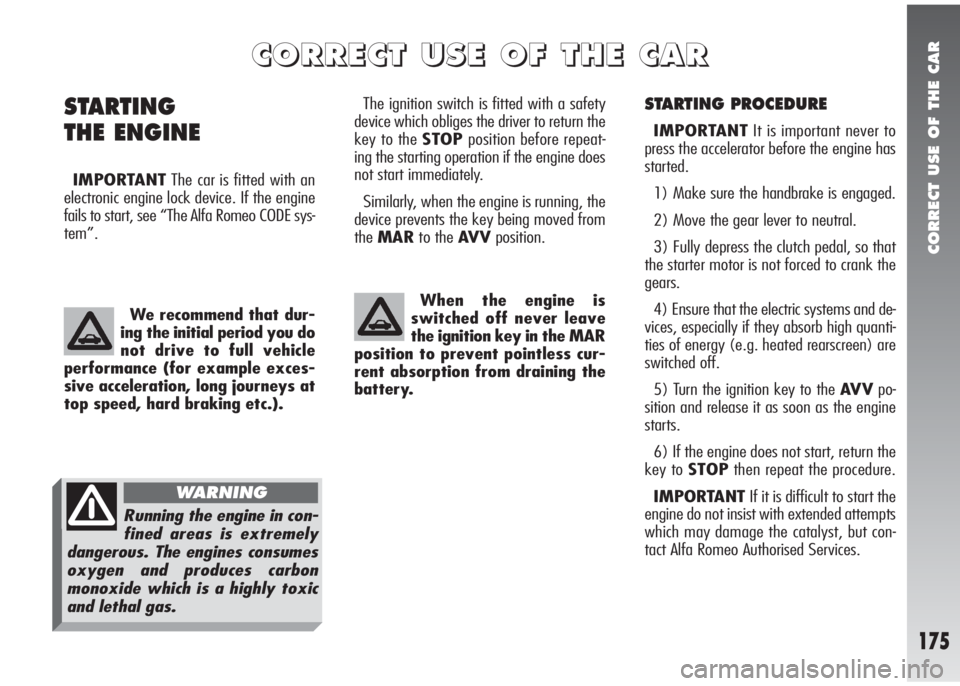
CORRECT USE OF THE CAR
175
STARTING PROCEDURE
IMPORTANTIt is important never to
press the accelerator before the engine has
started.
1) Make sure the handbrake is engaged.
2) Move the gear lever to neutral.
3) Fully depress the clutch pedal, so that
the starter motor is not forced to crank the
gears.
4) Ensure that the electric systems and de-
vices, especially if they absorb high quanti-
ties of energy (e.g. heated rearscreen) are
switched off.
5) Turn the ignition key to the AV Vpo-
sition and release it as soon as the engine
starts.
6) If the engine does not start, return the
key to STOPthen repeat the procedure.
IMPORTANTIf it is difficult to start the
engine do not insist with extended attempts
which may damage the catalyst, but con-
tact Alfa Romeo Authorised Services. The ignition switch is fitted with a safety
device which obliges the driver to return the
key to the STOPposition before repeat-
ing the starting operation if the engine does
not start immediately.
Similarly, when the engine is running, the
device prevents the key being moved from
theMARto the AV Vposition.
STARTING
THE ENGINE
IMPORTANTThe car is fitted with an
electronic engine lock device. If the engine
fails to start, see “The Alfa Romeo CODE sys-
tem”.
C C
O O
R R
R R
E E
C C
T T
U U
S S
E E
O O
F F
T T
H H
E E
C C
A A
R R
We recommend that dur-
ing the initial period you do
not drive to full vehicle
performance (for example exces-
sive acceleration, long journeys at
top speed, hard braking etc.).When the engine is
switched off never leave
the ignition key in the MAR
position to prevent pointless cur-
rent absorption from draining the
battery.
Running the engine in con-
fined areas is extremely
dangerous. The engines consumes
oxygen and produces carbon
monoxide which is a highly toxic
and lethal gas.
WARNING
Page 178 of 291
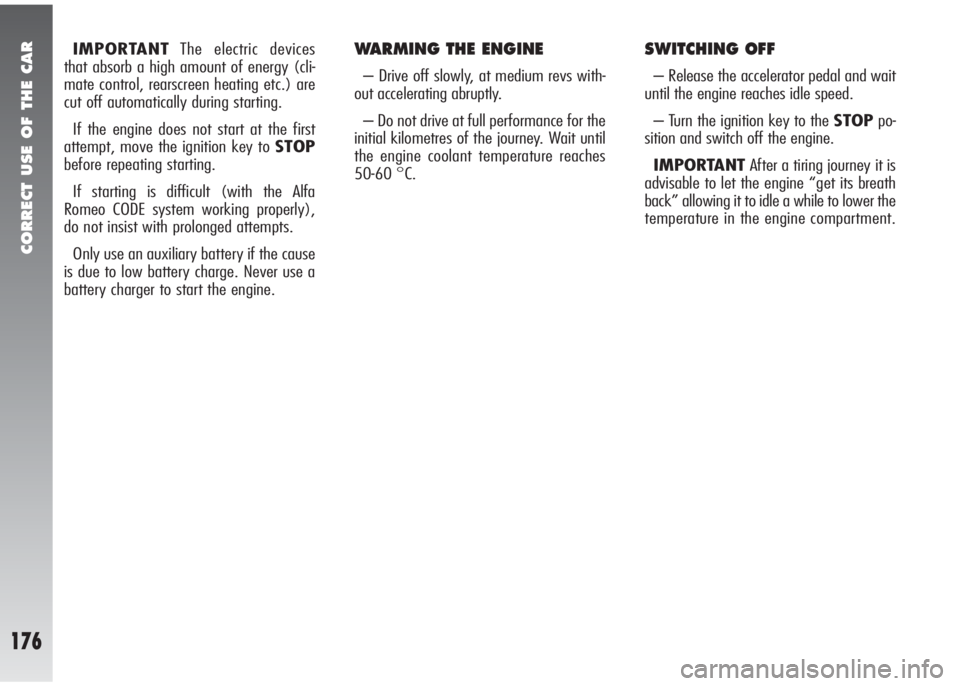
CORRECT USE OF THE CAR
176
IMPORTANTThe electric devices
that absorb a high amount of energy (cli-
mate control, rearscreen heating etc.) are
cut off automatically during starting.
If the engine does not start at the first
attempt, move the ignition key to STOP
before repeating starting.
If starting is difficult (with the Alfa
Romeo CODE system working properly),
do not insist with prolonged attempts.
Only use an auxiliary battery if the cause
is due to low battery charge. Never use a
battery charger to start the engine.WARMING THE ENGINE
– Drive off slowly, at medium revs with-
out accelerating abruptly.
– Do not drive at full performance for the
initial kilometres of the journey. Wait until
the engine coolant temperature reaches
50-60 °C.
SWITCHING OFF
– Release the accelerator pedal and wait
until the engine reaches idle speed.
– Turn the ignition key to the STOPpo-
sition and switch off the engine.
IMPORTANTAfter a tiring journey it is
advisable to let the engine “get its breath
back” allowing it to idle a while to lower the
temperature in the engine compartment.
Page 185 of 291

CORRECT USE OF THE CAR
183
Top speed
Fuel consumption considerably increases
with speed: it is helpful to note that passing
from 90 to 120 km/h consumption in-
creases by about +30%. Also maintain an
even as possible speed, avoiding superflu-
ous braking and accelerating again, which
cost in terms of both fuel and emissions. It
is therefore advisable to adopt a “smooth”
driving style trying to anticipate manoeuvres
to avoid imminent hazards and respect safe-
ty distances to avoid sudden slowing.
Acceleration
Accelerating heavily taking the engine to
a high speed, has a considerably adverse ef-
fect on consumption and emission levels;
it is wise to accelerate gradually and not ex-
ceed the maximum torque.CONDITIONS OF USE
Cold starting
Short journeys and frequent cold starts do
not allow the engine to reach optimum op-
erating temperature. This results in a sig-
nificant increase in consumption levels (from
+15 to +30% on the urban cycle) and emis-
sion of harmful substances.
Traffic situations and
road conditions
Rather high consumption levels are tied to
situations with heavy traffic, for example
in queues with frequent use of the lower
gears or in cities with many traffic lights.
Also winding mountain roads and rough
road surfaces adversely affect consumption.
Stopping in the traffic
During prolonged stops (e.g. level cross-
ings) it is advisable to switch the engine off.
ECONOMY AND
ENVIRONMENT
FRIENDLY DRIVING
Environment protection is one of the prin-
ciples that guided the development of your
Alfa 147 GTA.
It is not merely by chance that its antipol-
lution devices obtain results far beyond those
specified by current regulations.
However, the environment still needs the
utmost care from all of us.
By following a few simple rules it is pos-
sible to avoid damage to the environment
and very often at the same time to limit fu-
el consumption. On this subject we are giv-
ing some helpful suggestions to be added
to those marked with the
#in various points
of this booklet.
Kindly read them all carefully.
Page 190 of 291
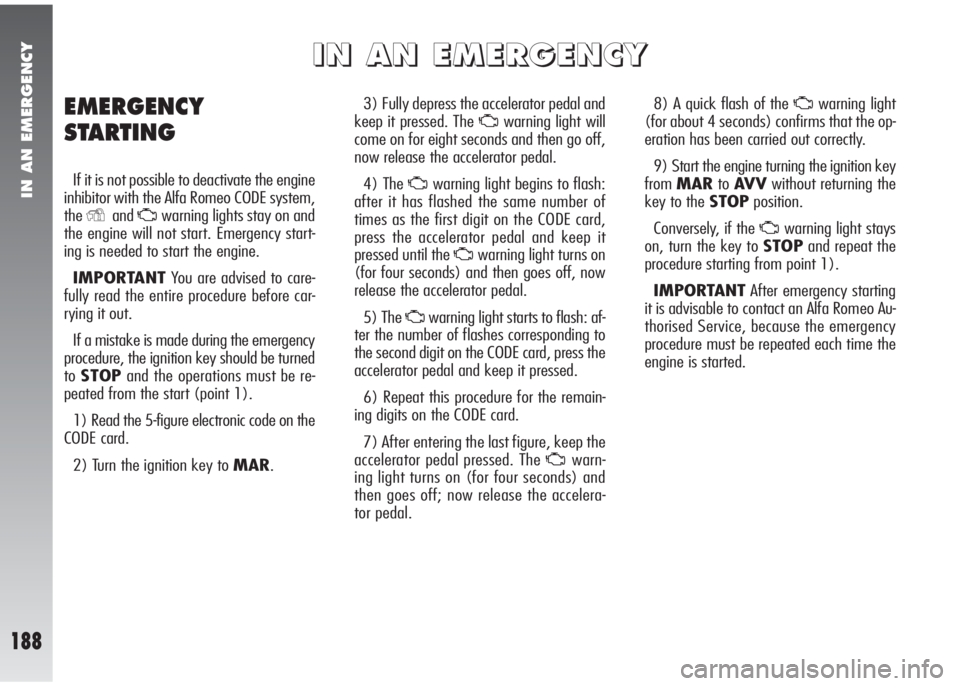
IN AN EMERGENCY
188
3) Fully depress the accelerator pedal and
keep it pressed. The
Uwarning light will
come on for eight seconds and then go off,
now release the accelerator pedal.
4) The
Uwarning light begins to flash:
after it has flashed the same number of
times as the first digit on the CODE card,
press the accelerator pedal and keep it
pressed until the
Uwarning light turns on
(for four seconds) and then goes off, now
release the accelerator pedal.
5) The
Uwarning light starts to flash: af-
ter the number of flashes corresponding to
the second digit on the CODE card, press the
accelerator pedal and keep it pressed.
6) Repeat this procedure for the remain-
ing digits on the CODE card.
7) After entering the last figure, keep the
accelerator pedal pressed. The
Uwarn-
ing light turns on (for four seconds) and
then goes off; now release the accelera-
tor pedal.8) A quick flash of the
Uwarning light
(for about 4 seconds) confirms that the op-
eration has been carried out correctly.
9) Start the engine turning the ignition key
fromMARtoAV Vwithout returning the
key to the STOPposition.
Conversely, if the
Uwarning light stays
on, turn the key to STOPand repeat the
procedure starting from point 1).
IMPORTANTAfter emergency starting
it is advisable to contact an Alfa Romeo Au-
thorised Service, because the emergency
procedure must be repeated each time the
engine is started.
EMERGENCY
STARTING
If it is not possible to deactivate the engine
inhibitor with the Alfa Romeo CODE system,
the
YandUwarning lights stay on and
the engine will not start. Emergency start-
ing is needed to start the engine.
IMPORTANTYou are advised to care-
fully read the entire procedure before car-
rying it out.
If a mistake is made during the emergency
procedure, the ignition key should be turned
toSTOPand the operations must be re-
peated from the start (point 1).
1) Read the 5-figure electronic code on the
CODE card.
2) Turn the ignition key to MAR.
I I
N N
A A
N N
E E
M M
E E
R R
G G
E E
N N
C C
Y Y
Page 196 of 291
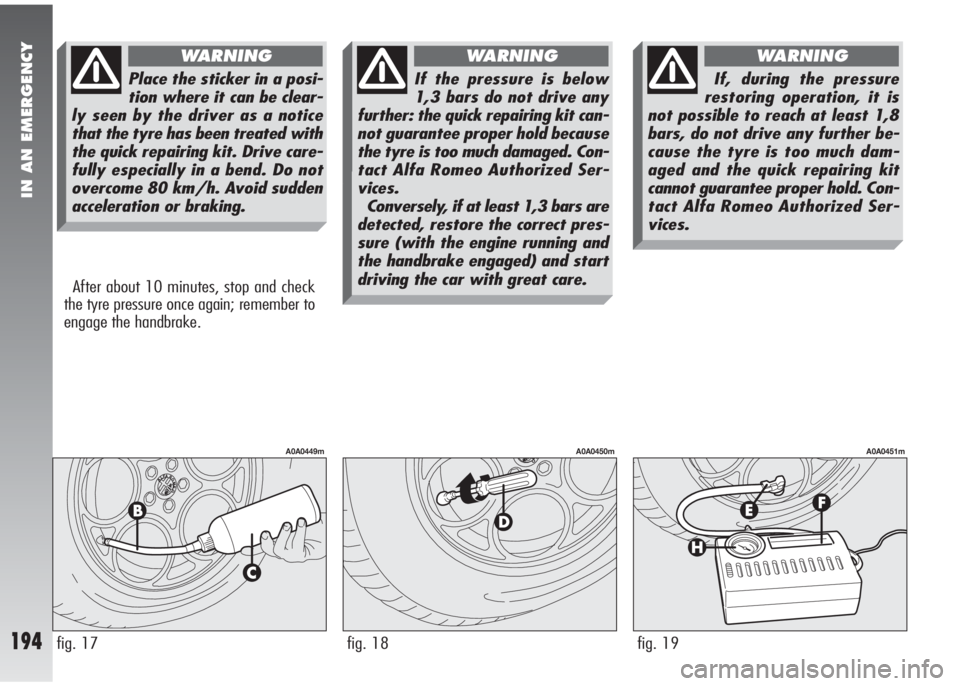
IN AN EMERGENCY
194fig. 17
A0A0449m
fig. 18
A0A0450m
fig. 19
A0A0451m
After about 10 minutes, stop and check
the tyre pressure once again; remember to
engage the handbrake.
Place the sticker in a posi-
tion where it can be clear-
ly seen by the driver as a notice
that the tyre has been treated with
the quick repairing kit. Drive care-
fully especially in a bend. Do not
overcome 80 km/h. Avoid sudden
acceleration or braking.
WARNING
If the pressure is below
1,3 bars do not drive any
further: the quick repairing kit can-
not guarantee proper hold because
the tyre is too much damaged. Con-
tact Alfa Romeo Authorized Ser-
vices.
Conversely, if at least 1,3 bars are
detected, restore the correct pres-
sure (with the engine running and
the handbrake engaged) and start
driving the car with great care.
WARNING
If, during the pressure
restoring operation, it is
not possible to reach at least 1,8
bars, do not drive any further be-
cause the tyre is too much dam-
aged and the quick repairing kit
cannot guarantee proper hold. Con-
tact Alfa Romeo Authorized Ser-
vices.
WARNING
Page 219 of 291
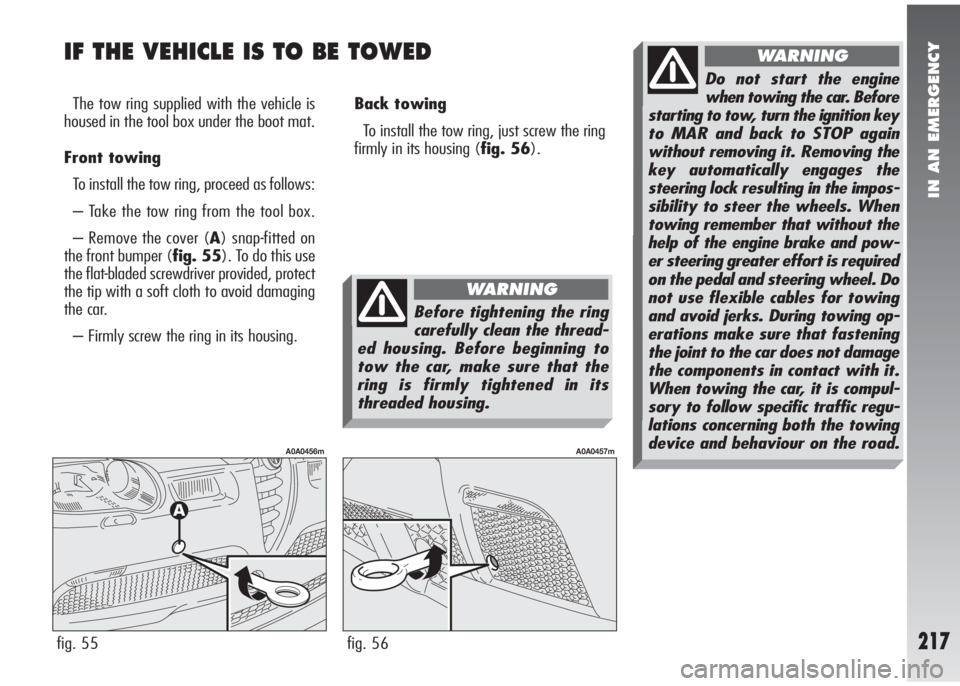
IN AN EMERGENCY
217
IF THE VEHICLE IS TO BE TOWED
The tow ring supplied with the vehicle is
housed in the tool box under the boot mat.
Front towing
To install the tow ring, proceed as follows:
– Take the tow ring from the tool box.
– Remove the cover (A) snap-fitted on
the front bumper (fig. 55). To do this use
the flat-bladed screwdriver provided, protect
the tip with a soft cloth to avoid damaging
the car.
– Firmly screw the ring in its housing.Back towing
To install the tow ring, just screw the ring
firmly in its housing (fig. 56).
fig. 55
A0A0456m
fig. 56
A0A0457m
Before tightening the ring
carefully clean the thread-
ed housing. Before beginning to
tow the car, make sure that the
ring is firmly tightened in its
threaded housing.
WARNING
Do not start the engine
when towing the car. Before
starting to tow, turn the ignition key
to MAR and back to STOP again
without removing it. Removing the
key automatically engages the
steering lock resulting in the impos-
sibility to steer the wheels. When
towing remember that without the
help of the engine brake and pow-
er steering greater effort is required
on the pedal and steering wheel. Do
not use flexible cables for towing
and avoid jerks. During towing op-
erations make sure that fastening
the joint to the car does not damage
the components in contact with it.
When towing the car, it is compul-
sory to follow specific traffic regu-
lations concerning both the towing
device and behaviour on the road.
WARNING